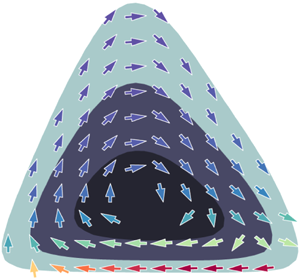Crossref Citations
This article has been cited by the following publications. This list is generated based on data provided by
Crossref.
Doohan, Patrick
Willis, Ashley P.
and
Hwang, Yongyun
2021.
Minimal multi-scale dynamics of near-wall turbulence.
Journal of Fluid Mechanics,
Vol. 913,
Issue. ,
Jiao, Yuxin
Hwang, Yongyun
and
Chernyshenko, Sergei I.
2021.
Orr mechanism in transition of parallel shear flow.
Physical Review Fluids,
Vol. 6,
Issue. 2,
Lozano-Durán, Adrián
Constantinou, Navid C.
Nikolaidis, Marios-Andreas
and
Karp, Michael
2021.
Cause-and-effect of linear mechanisms sustaining wall turbulence.
Journal of Fluid Mechanics,
Vol. 914,
Issue. ,
Jiao, Yuxin
Chernyshenko, Sergei I.
and
Hwang, Yongyun
2022.
A driving mechanism of near-wall turbulence subject to adverse pressure gradient in a plane Couette flow.
Journal of Fluid Mechanics,
Vol. 941,
Issue. ,
Jiménez, Javier
2022.
The streaks of wall-bounded turbulence need not be long.
Journal of Fluid Mechanics,
Vol. 945,
Issue. ,
Jagodinski, Eric
Zhu, Xingquan
and
Verma, Siddhartha
2023.
Inverse identification of dynamically important regions in turbulent flows using three-dimensional convolutional neural networks.
Physical Review Fluids,
Vol. 8,
Issue. 9,
Nikolaidis, Marios-Andreas
Ioannou, Petros J.
Farrell, Brian F.
and
Lozano-Durán, Adrián
2023.
POD-based study of turbulent plane Poiseuille flow: comparing structure and dynamics between quasi-linear simulations and DNS.
Journal of Fluid Mechanics,
Vol. 962,
Issue. ,
Jiménez, Javier
2023.
A Perron–Frobenius analysis of wall-bounded turbulence.
Journal of Fluid Mechanics,
Vol. 968,
Issue. ,
Liu, Yixun
Liu, Chun-Ho
Brasseur, Guy P.
and
Chao, Christopher Y.H.
2023.
Proper orthogonal decomposition of large-eddy simulation data over real urban morphology.
Sustainable Cities and Society,
Vol. 89,
Issue. ,
p.
104324.
Holford, Jacob J.
Lee, Myoungkyu
and
Hwang, Yongyun
2023.
Optimal white-noise stochastic forcing for linear models of turbulent channel flow.
Journal of Fluid Mechanics,
Vol. 961,
Issue. ,
Ciola, N.
De Palma, P.
Robinet, J.-C.
and
Cherubini, S.
2023.
Nonlinear optimal perturbation of turbulent channel flow as a precursor of extreme events.
Journal of Fluid Mechanics,
Vol. 970,
Issue. ,
Liu, Yixun
Liu, Chun-Ho
Brasseur, Guy P.
and
Chao, Christopher Y.H.
2023.
Wavelet analysis of the atmospheric flows over real urban morphology.
Science of The Total Environment,
Vol. 859,
Issue. ,
p.
160209.
Liu, Yixun
Liu, Chun-Ho
Brasseur, Guy P.
and
Chao, Christopher Y.H.
2023.
Empirical mode decomposition of the atmospheric flows and pollutant transport over real urban morphology.
Environmental Pollution,
Vol. 331,
Issue. ,
p.
121858.
Ballouz, Eric
Lopez-Doriga, Barbara
Dawson, Scott T.M.
and
Bae, H. Jane
2024.
Wavelet-based resolvent analysis of non-stationary flows.
Journal of Fluid Mechanics,
Vol. 999,
Issue. ,
Vela-Martín, Alberto
and
Avila, Marc
2024.
Large-scale patterns set the predictability limit of extreme events in Kolmogorov flow.
Journal of Fluid Mechanics,
Vol. 986,
Issue. ,
Yu, Ming
Zhou, ZiSong
Dong, SiWei
Yuan, XianXu
and
Xu, ChunXiao
2024.
On the generation of near-wall dilatational motions in hypersonic turbulent boundary layers.
Journal of Fluid Mechanics,
Vol. 984,
Issue. ,
Jiménez, Javier
2024.
Fake turbulence.
Journal of Fluid Mechanics,
Vol. 990,
Issue. ,
Ballouz, Eric
Dawson, Scott T.M.
and
Bae, Hyunji Jane
2025.
Transient growth and nonlinear breakdown of wavelet-based resolvent modes in turbulent channel flow.
Journal of Fluid Mechanics,
Vol. 1016,
Issue. ,

 $\text{Q}_{2}$–
$\text{Q}_{2}$– $\text{Q}_{4}$ events of the Reynolds stress.
$\text{Q}_{4}$ events of the Reynolds stress.
